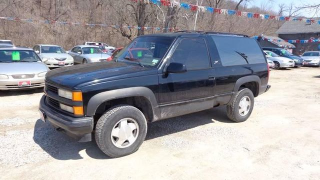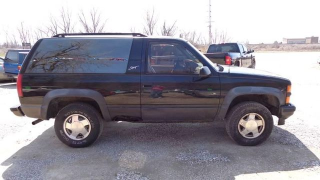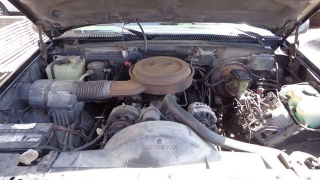The Good
The 1994 Chevrolet Blazer offered practical advantages like a robust V6 engine for decent performance and impressive towing capacity, appealing to those needing power. Its straightforward design and readily available parts contributed to good long-term value and relative ease of maintenance, a practical draw. Emotionally, its classic SUV styling and perceived ruggedness evoked a sense of adventure and freedom, making it a versatile choice for both work and play, blending utility with an iconic American look.
The Bad
Potential weaknesses for the 1994 Chevrolet Blazer include susceptibility to rust, particularly in northern climates, and common electrical issues that can be tricky to diagnose. Owners frequently report problems with the fuel pump, intake manifold gaskets, and front suspension components wearing out. Its fuel economy, especially with the 4WD system, is also a notable drawback compared to modern vehicles.
1994 Chevrolet Blazer: Quick Overview
The 1994 Chevrolet Blazer, specifically the S-10 Blazer model, offered a range of specifications tailored for utility and performance:
- Engine Options: The primary engine offered was the 4.3L "Vortec" V6 (RPO L35 CPI – Central Port Injection). While earlier models of this generation offered a 4-cylinder, the V6 was standard or widely available in '94.
- Horsepower: The 4.3L V6 engine typically produced around 195 horsepower and 260 lb-ft of torque. This provided a good balance of power for daily driving and light-duty hauling.
- Fuel Economy: Fuel economy for the 4.3L V6 varied significantly with transmission and drivetrain. Estimates were roughly 15-17 MPG city and 20-22 MPG highway for 2WD models, dropping slightly for 4WD versions. These figures are based on EPA estimates from that era.
- 0-60 Times: While not a performance vehicle, 0-60 mph times for the 4.3L V6 were generally in the 9.0-10.0 second range, which was competitive for an SUV of its class at the time.
- Towing Capacity: A significant advantage, the 1994 Blazer with the 4.3L V6 engine and proper equipment could tow up to 5,500 to 6,000 pounds, making it suitable for trailers, boats, or campers.
- Trim-Level Features:
- Base: Typically came with manual windows and locks, AM/FM radio, basic cloth interior, and steel wheels. Focus was on practicality and affordability.
- LS: Added features like power windows and locks, air conditioning (often optional), tilt steering, cruise control, and improved cloth upholstery. Exterior often featured styled steel or aluminum wheels.
- LT: The top-tier trim offered more luxurious amenities such as premium cloth or leather-appointed seating (optional), full power accessories, upgraded audio system, remote keyless entry, alloy wheels, and often included features like a rear window defogger and tinted glass. Four-wheel drive was also a popular option across all trims.
1994 Chevrolet Blazer Specifications
Vehicle Information
| Year | 1994 |
| Make | Chevrolet |
| Model | Blazer |
| Trim | - |
| Style | 4-Door 2WD 5-Speed Manual |
| Type | Sport Utility Vehicle |
| Category | Standard Sport Utility Vehicle |
Manufacturing Details
| Made In | United States |
| Manufacturing City | JANESVILLE |
Dimensions
| Doors | 4-Door |
| Curb Weight | 3536 pounds |
| Gross Vehicle Weight Rating | - |
| Overall Height | 64.10 inches |
| Overall Length | 176.80 inches |
| Overall Width | 65.40 inches |
| Wheelbase Length | 107.00 inches |
| Standard Seating | 3 |
Engine & Performance
| Engine | 4.3-L V-6 OHV 12V |
| Engine Size | 4.3L |
| Engine Cylinders | 6 |
| Transmission | 5-Speed Manual |
| Transmission Type | Manual |
| Transmission Speeds | 5-Speed |
| Drivetrain | Rear-Wheel Drive |
Additional Features
| Anti-Brake System | 2-Wheel ABS |
| Steering Type | Recirculating |
Pricing
| Manufacturer Suggested Retail Price (MSRP) | $17,131 |
| Invoice Price | - |
| Delivery Charges | - |
Vehicle History Report
Specifications
History
Events
History Check
Check
Check
Check
Check
Listings
Recalls
Check
Analysis
What Problems Does the 1994 Chevrolet Blazer Have?
Another significant concern is the fuel pump, which often fails, leaving owners stranded. Replacement can be labor-intensive as it's located within the fuel tank. Electrical problems are also widespread, ranging from faulty gauges and instrument cluster issues to power window motor failures and problems with the HVAC blower motor.
Front suspension components, including ball joints, tie rod ends, and idler arms, are known to wear out, requiring regular replacement, especially on vehicles that have seen rougher use or higher mileage. Rust is a perennial issue, particularly on the frame, rocker panels, rear quarter panels, and around the wheel wells, especially in regions exposed to road salt.
Brake issues, such as premature wear of pads and rotors, as well as ABS sensor failures, are also reported. For the 1994 model year specifically, the Central Port Injection (CPI) system used on the 4.3L V6 can develop issues with clogged or leaking fuel injectors within the "spider" assembly, leading to misfires and poor performance.
Recalls for the 1994 Chevrolet S-10 Blazer have included issues related to:
- Front seat belt buckle: Potential for buckle to unlatch unexpectedly. (Recall 93V187000)
- Antilock brake system (ABS) module: Potential for fluid leakage and fire risk. (Recall 98V006000, though this often affected a broader range of GM trucks/SUVs)
How long will the 1994 Chevrolet Blazer last?
What Technology & Safety Features are Included?
Driver-assistance features were very limited. Power steering and power brakes were standard, making driving more manageable. Antilock Brakes (ABS) were an optional or sometimes standard safety feature, primarily on the rear wheels (RABS) for many models, or four-wheel ABS on higher trims or later in the generation. Cruise control was a common optional convenience feature, especially on LS and LT trims, providing assistance on long highway drives.
Safety features were rudimentary by today's standards. The 1994 Blazer typically came equipped with:
- Driver's side airbag: This was a relatively new inclusion for many vehicles in this era, becoming standard in '94.
- Three-point seatbelts: For front occupants and outboard rear passengers.
- Side-impact door beams: Designed to provide some protection in side collisions.
- Child safety locks: On two-door models, this applied to the rear hatch.
Regarding crash-test ratings, comprehensive and standardized ratings like those from the IIHS (Insurance Institute for Highway Safety) or NHTSA (National Highway Traffic Safety Administration) as we know them today were not as widely published or as detailed for vehicles of this vintage. Specific 1994 Blazer crash test data is scarce or less comparable to modern tests. However, generally, vehicles from this era offered significantly less occupant protection than contemporary designs, lacking advanced crumple zones, multiple airbags, and sophisticated electronic stability systems.
What Colors Options are Available?
1994 Chevrolet Blazer Prices and Market Value
Depreciation insights show that most of its value loss occurred within the first decade. Factors affecting its current resale value include overall condition (rust being a major detractor), mileage, mechanical reliability, whether it's 2WD or 4WD (4WD often commands a premium), trim level, and the presence of desirable options like air conditioning and power accessories. Originality and complete service records also play a role in securing a higher price.
1994 Chevrolet Blazer Cost of Ownership
Repair costs can fluctuate. While individual parts are cheap, recurring issues like intake manifold gaskets, fuel pumps, and suspension components can add up over time. Rust repair, if needed, can be very costly. Overall, it's a moderately costly vehicle to own long-term due to its fuel consumption and the cumulative effect of age-related repairs, despite cheap insurance and accessible parts. It's not an 'economical' car in the modern sense but can be affordable for those willing to do some wrenching.
1994 Chevrolet Blazer Fuel Efficiency
1994 Chevrolet Blazer Safety Rating
NHTSA
IIHS
1994 Chevrolet Blazer Warranty
Basic
Powertrain
Rust
1994 Chevrolet Blazer Insurance
reasonable repair costs.
How Does the 1994 Chevrolet Blazer Compare to Other Sport Utility Vehicle?
In terms of performance, the Blazer's 4.3L V6 offered a strong balance of power and towing capacity, often outclassing the base engines of the Explorer (4.0L V6) and Cherokee (4.0L I6) in raw torque, though the Jeep's 4.0L was renowned for its bulletproof reliability. The Pathfinder, with its 3.0L V6, was generally less powerful.
Features were quite comparable across the board; all offered similar levels of creature comforts for their respective trim levels, including power accessories, air conditioning, and basic audio systems. The Blazer's two-door configuration (which was still common in '94, though the 4-door was gaining traction) offered a sportier profile but less practicality than a four-door Explorer or Pathfinder.
Reliability is where distinctions emerged. While the Blazer's 4.3L V6 was robust, its intake manifold gasket issues and electrical gremlins were common. The Jeep Cherokee's 4.0L "Renix" or "HO" straight-six engine is legendary for its durability, often outlasting the vehicle itself, though it also had its share of cooling system and rust concerns. The Ford Explorer faced known transmission issues (especially the A4LD) and persistent rust. The Pathfinder was generally quite reliable mechanically but could also suffer from rust.
Price-wise, all were competitively priced when new. In the used market today, their values are similar, heavily dependent on condition.
For alternatives, if off-road capability and supreme reliability are paramount, the Jeep Cherokee (XJ) is a strong contender. For a slightly more refined ride and greater passenger space, a Ford Explorer (though watch for transmission issues) might be considered. If a more modern, slightly more comfortable classic SUV is desired, looking at later models in the Blazer's own generation (post-1995 for the redesigned S-10 Blazer) or even early 2000s Japanese SUVs like a Toyota 4Runner (more expensive) or Nissan Xterra could be better, albeit in a different price bracket for the 4Runner.
Final Verdict: Is the 1994 Chevrolet Blazer a Good Sport Utility Vehicle?
Is it worth buying? Yes, but under specific conditions. It's worth buying if you find one in relatively good condition, especially if it has minimal rust and a well-maintained engine. It's particularly appealing if you're comfortable with DIY maintenance or have access to affordable repairs, as its age means ongoing attention will be required. It's not ideal as a primary, daily driver for someone seeking modern comforts, fuel efficiency, or advanced safety features. Focus on 4WD models for maximum utility and inspect thoroughly for rust and common mechanical issues before purchase. For those seeking a nostalgic, tough, and affordable SUV that can still handle light-duty tasks, the '94 Blazer offers good value.


